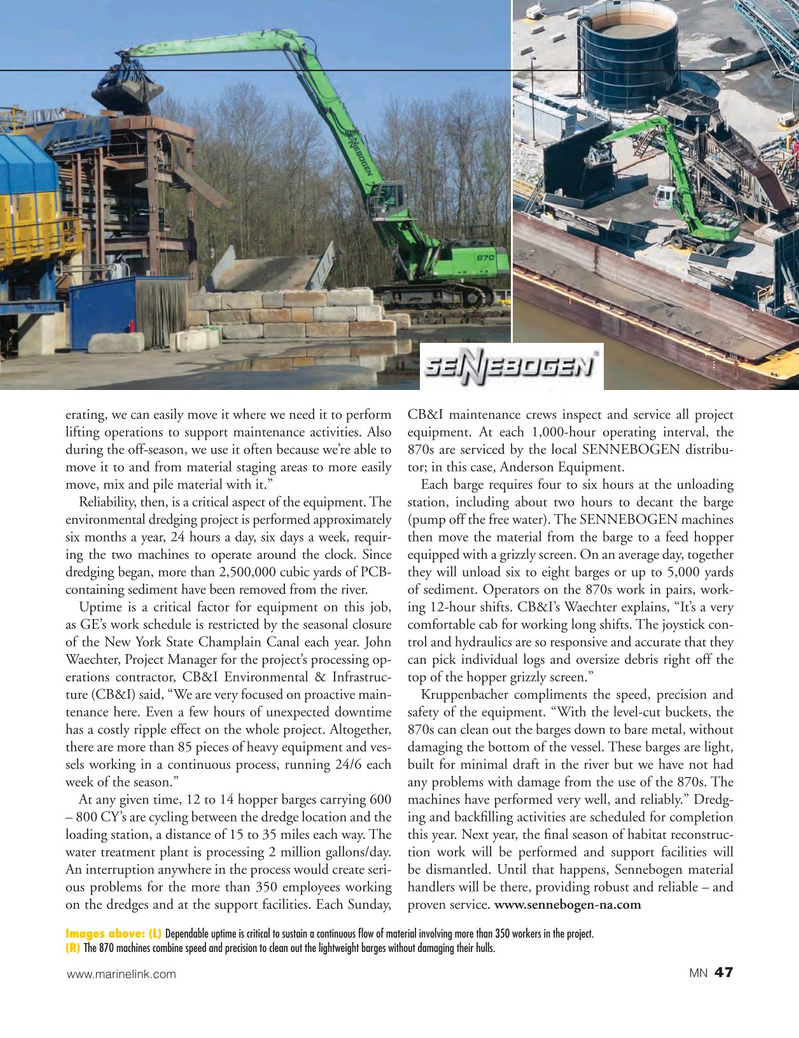
Page 47: of Marine News Magazine (September 2016)
Offshore Annual
Read this page in Pdf, Flash or Html5 edition of September 2016 Marine News Magazine
erating, we can easily move it where we need it to perform CB&I maintenance crews inspect and service all project lifting operations to support maintenance activities. Also equipment. At each 1,000-hour operating interval, the during the off-season, we use it often because we’re able to 870s are serviced by the local SENNEBOGEN distribu- move it to and from material staging areas to more easily tor; in this case, Anderson Equipment.
move, mix and pile material with it.” Each barge requires four to six hours at the unloading
Reliability, then, is a critical aspect of the equipment. The station, including about two hours to decant the barge environmental dredging project is performed approximately (pump off the free water). The SENNEBOGEN machines six months a year, 24 hours a day, six days a week, requir- then move the material from the barge to a feed hopper ing the two machines to operate around the clock. Since equipped with a grizzly screen. On an average day, together dredging began, more than 2,500,000 cubic yards of PCB- they will unload six to eight barges or up to 5,000 yards containing sediment have been removed from the river. of sediment. Operators on the 870s work in pairs, work-
Uptime is a critical factor for equipment on this job, ing 12-hour shifts. CB&I’s Waechter explains, “It’s a very as GE’s work schedule is restricted by the seasonal closure comfortable cab for working long shifts. The joystick con- of the New York State Champlain Canal each year. John trol and hydraulics are so responsive and accurate that they
Waechter, Project Manager for the project’s processing op- can pick individual logs and oversize debris right off the erations contractor, CB&I Environmental & Infrastruc- top of the hopper grizzly screen.” ture (CB&I) said, “We are very focused on proactive main- Kruppenbacher compliments the speed, precision and tenance here. Even a few hours of unexpected downtime safety of the equipment. “With the level-cut buckets, the has a costly ripple effect on the whole project. Altogether, 870s can clean out the barges down to bare metal, without there are more than 85 pieces of heavy equipment and ves- damaging the bottom of the vessel. These barges are light, sels working in a continuous process, running 24/6 each built for minimal draft in the river but we have not had week of the season.” any problems with damage from the use of the 870s. The
At any given time, 12 to 14 hopper barges carrying 600 machines have performed very well, and reliably.” Dredg- – 800 CY’s are cycling between the dredge location and the ing and back? lling activities are scheduled for completion loading station, a distance of 15 to 35 miles each way. The this year. Next year, the ? nal season of habitat reconstruc- water treatment plant is processing 2 million gallons/day. tion work will be performed and support facilities will
An interruption anywhere in the process would create seri- be dismantled. Until that happens, Sennebogen material ous problems for the more than 350 employees working handlers will be there, providing robust and reliable – and on the dredges and at the support facilities. Each Sunday, proven service. www.sennebogen-na.com
Images above: (L) Dependable uptime is critical to sustain a continuous ? ow of material involving more than 350 workers in the project.
(R) The 870 machines combine speed and precision to clean out the lightweight barges without damaging their hulls.
47 www.marinelink.com MN
MN Sept16 Layout 32-49.indd 47 8/22/2016 10:16:44 AM

 46
46

 48
48
